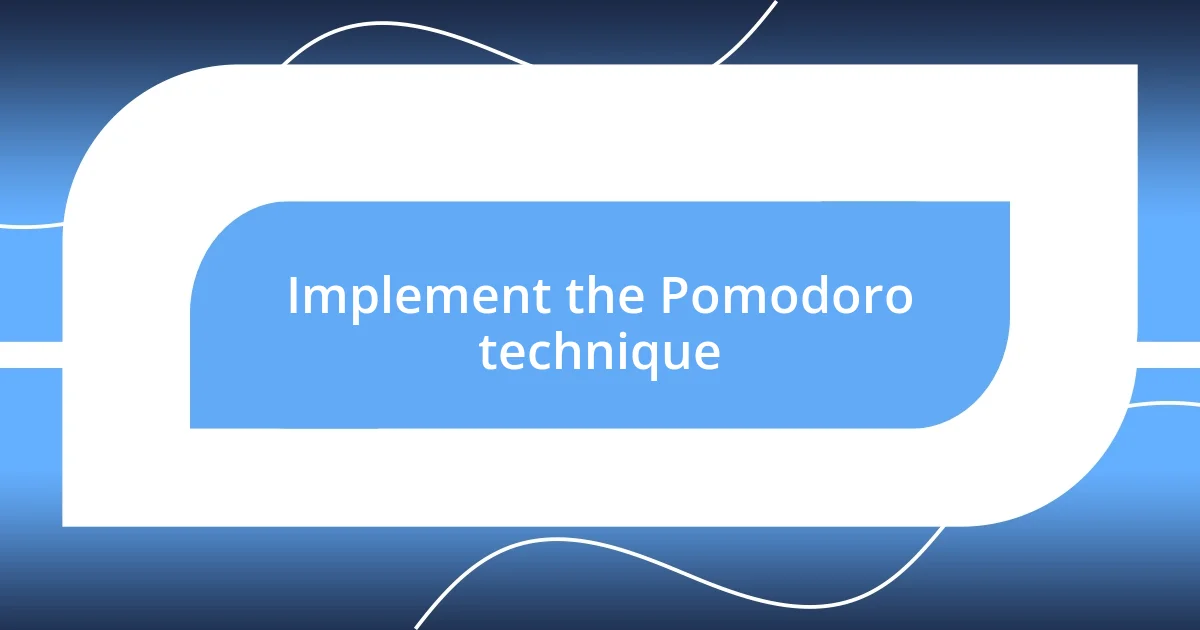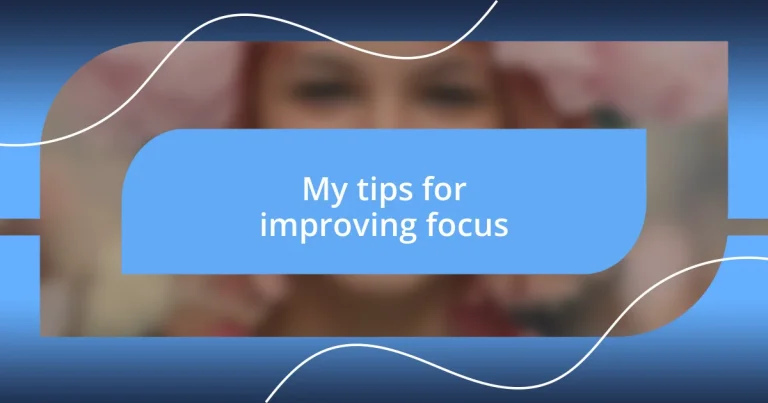Key takeaways:
- Understanding and identifying personal distractions, along with energy and mood influences, can significantly enhance focus.
- Utilizing methods like the Pomodoro technique and the Eisenhower Matrix helps structure tasks and maintain productivity through focused intervals and prioritization.
- Incorporating mindfulness, regular physical activity, and regularly reviewing strategies fosters mental clarity and adaptability in maintaining focus.

Understand your focus challenges
Understanding your focus challenges can be a real eye-opener for many of us. I remember a time when I felt overwhelmed by distractions—my phone buzzing, emails popping up, and the constant lure of social media. Have you experienced that nagging pull toward everything except what you need to accomplish?
I often found myself chasing shiny objects, moving from one task to another without completing anything. This fragmented attention led me to ask critically, “What exactly keeps pulling me away?” Identifying my specific distractions, like the urge to check my notifications every few minutes, helped me grasp where my focus slipped away.
Taking time to reflect on my energy levels and emotional state was crucial. I discovered that on days when I was feeling more anxious or fatigued, my ability to concentrate dwindled. Have you noticed how your mood affects your focus too? Recognizing these patterns was a game-changer for me, allowing me to adjust my strategies for better focus.

Establish a distraction-free environment
Creating a distraction-free environment is essential for fostering a focused mindset. I’ve often found that even the smallest interruptions can derail my concentration. For instance, I used to think that working with background music was fine, but I quickly realized that even the lyrics pulled my attention away from important tasks. Now, I opt for instrumental music or complete silence, which dramatically enhances my productivity.
To set up your distraction-free space, consider these tips:
– Declutter your workspace: A clean environment reduces visual distractions and helps you stay centered.
– Limit digital distractions: Turn off notifications on your devices and use apps that block distracting websites during work hours.
– Use noise-canceling headphones: These can help drown out ambient noise and create a personal bubble conducive to focus.
– Designate a specific area for work: Having a dedicated spot can condition your mind to associate that space with productivity.

Implement the Pomodoro technique
Implementing the Pomodoro technique has transformed the way I tackle my tasks. This method involves working for 25 minutes, then taking a 5-minute break. I remember the first time I used it; I was amazed at how much I accomplished in those focused intervals. It’s like training my brain to lock in on a task, knowing that a break is just around the corner. Have you felt that thrill when time seems to fly and you’re immersed in what you’re doing?
During my work sessions, I started to notice patterns in my concentration. I realized that after a few Pomodoros, my mind felt less fatigued. Short breaks allowed me to reset and return to my tasks with renewed energy and focus. This rhythm kept me engaged and productive. Have you noticed how stepping away from a task can sometimes provide new insights when you return?
Using a simple timer makes the Pomodoro technique easy to implement. I even picked a kitchen timer that dings at the end of each session; it adds a playful element to my productivity, almost like a game. As I became more consistent with the technique, my ability to focus significantly improved. I began to look forward to my work sessions instead of dreading them, which is a change I never anticipated.
| Aspect | Traditional Work Method | Pomodoro Technique |
|---|---|---|
| Duration of Work | Varied, often lengthy | 25 minutes |
| Breaks | Long, often ad-hoc | 5 minutes after each session |
| Focus | Potentially fragmented | Intensely concentrated |
| Energy Levels | Often declines over time | Refreshes with breaks |
| Task Completion | Tasks may linger | Increases chances of finishing |

Prioritize your tasks effectively
When it comes to prioritizing tasks effectively, I’ve discovered the power of the Eisenhower Matrix. This tool helps me sort tasks based on urgency and importance. By categorizing my to-dos, I can focus on what truly matters, leading to a satisfying sense of accomplishment. Have you ever felt overwhelmed by a long list of tasks, only to realize most of them weren’t even pressing?
In my daily routine, I often jot down tasks and sort them into four quadrants: urgent and important, important but not urgent, urgent but not important, and neither. When I first started using this method, it opened my eyes to how much time I was spending on tasks that didn’t significantly impact my goals. By focusing on the important ones first, I not only felt more productive but also less stressed. Does this sound familiar to you? It’s like finding clarity amid chaos.
Another technique I employ involves setting clear deadlines, which has amplified my focus. For instance, I recently challenged myself to complete a project by Sunday night. Having that deadline hanging over me ignited my motivation, transforming my work approach. As I drew closer to the deadline, my focus sharpened, and I was amazed at how much I could accomplish in a compressed timeframe. Isn’t it fascinating how a little pressure can be a catalyst for productivity? By setting deadlines, I consistently navigate my tasks with intention, which keeps me aligned with my goals.

Utilize mindfulness and meditation
Utilizing mindfulness and meditation has truly become a game-changer for me. I remember the first time I sat down to meditate; initially, my mind was a whirlwind of thoughts. But as I focused on my breath, the chaos began to quiet, and I felt a surprising sense of clarity. It’s fascinating how just a few minutes of this practice can center me, making it easier to focus on my tasks afterward. Have you ever noticed how just a moment of stillness can shift your entire mindset?
One technique I’ve found particularly helpful is mindful breathing. When I start to feel overwhelmed by my workload, I take a moment to simply breathe deeply and slowly. As I inhale and exhale, I let go of distractions. This practice not only relaxes me but also increases my concentration when I return to my tasks. What I appreciate most is the way this simple act brings me back to the present moment, allowing me to engage fully with whatever I’m doing. Have you ever tried stopping to notice your breath in a busy moment? The difference is remarkable.
Incorporating mindfulness into my daily routine has also opened my eyes to the joys of being present. I often find myself grateful for moments that I once overlooked. For example, during my morning coffee, instead of getting lost in my phone, I take a few moments to savor the aroma and taste. This small practice doesn’t just ground me; it helps me transition into my day with intention. Have you felt this shift when you immerse yourself in a simple experience? Embracing mindfulness enhances my focus and enriches my day-to-day life, proving that sometimes, slowing down can be the key to speeding up our productivity.

Incorporate regular physical activity
In my experience, incorporating regular physical activity into my routine has significantly boosted my focus. I remember a time when I struggled to stay attentive on long workdays. It was during one of those afternoons that I decided to step outside for a brisk walk. I felt an immediate shift in my mindset, as the fresh air revitalized my senses. Have you ever noticed how a little movement can shake off the lethargy and spark creativity?
What I’ve discovered is that even brief exercise sessions—like a quick dance break or a few stretches at my desk—can break up the monotony of work. Just yesterday, after I did a few jumping jacks during a writing session, I returned to my task feeling invigorated. My thoughts flowed more freely, and I tackled several challenging paragraphs in no time. Doesn’t it feel rewarding to realize that a few minutes of movement can propel your productivity?
I also find that committing to regular workouts helps me maintain a clear mind throughout the day. On days when I hit the gym in the morning, I notice significant gains in my concentration and mood. It’s as if each workout clears a mental fog, allowing me to confront my tasks with newfound clarity. Have you felt that shift after a workout? It’s incredible how instilling a consistent exercise routine can serve as a powerful ally in enhancing focus.

Review and adjust your strategies
When it comes to reviewing and adjusting my focus strategies, I’ve found that reflection is key. Just last week, I took some time to evaluate which techniques were actually working for me. I realized that while meditation has been fantastic, I’d started skimping on my mindfulness practice during busy days. It made me wonder, have you noticed how easy it is to overlook the very tools that help us thrive when we get caught up in the relentless pace of life?
In addition to taking stock of what’s working, I’ve learned to be flexible and willing to shift my approach. For instance, I used to rely heavily on to-do lists, but I noticed they felt overwhelming at times. By switching to time-blocking—allocating specific chunks of time to work on tasks—I saw a significant uptick in my focus. Isn’t it amazing how a slight tweak can completely transform our productivity?
It’s essential to embrace this evolving process. Just like clothing styles change, our focus strategies need to adapt as we grow. I try to check in with myself weekly, asking questions like, “What helped me focus last week, and where did I falter?” This practice empowers me to make necessary adjustments. Have you ever taken a moment to reassess your own focus methods? It’s a rewarding experience that often leads to unexpected breakthroughs.












